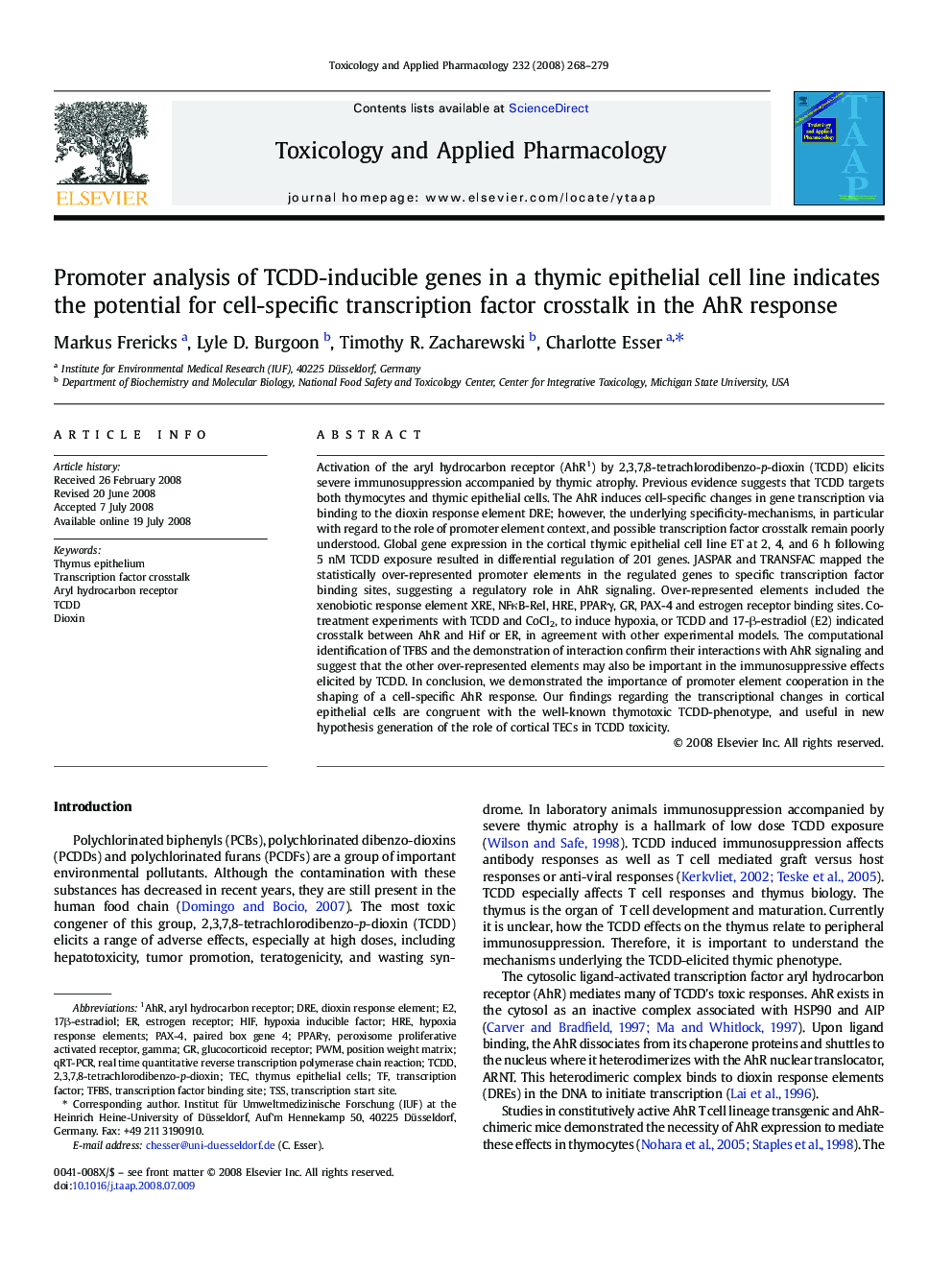| کد مقاله | کد نشریه | سال انتشار | مقاله انگلیسی | نسخه تمام متن |
|---|---|---|---|---|
| 2571131 | 1128618 | 2008 | 12 صفحه PDF | دانلود رایگان |
عنوان انگلیسی مقاله ISI
Promoter analysis of TCDD-inducible genes in a thymic epithelial cell line indicates the potential for cell-specific transcription factor crosstalk in the AhR response
دانلود مقاله + سفارش ترجمه
دانلود مقاله ISI انگلیسی
رایگان برای ایرانیان
کلمات کلیدی
TSSTFBSTECPWMqRT-PCRPPARγDRETCDDHREHIF17β-estradiol - 17β استرادیول2,3,7,8-Tetrachlorodibenzo-p-dioxin - 2،3،7،8-تترا کلریدیبنزوپتوفان دیوکسینDioxin - دیوکسینtranscription start site - رونویسی شروع سایتtranscription factor binding site - سایت اتصال فاکتور رونویسیthymus epithelial cells - سلول های اپی تلیوم تیماسTranscription factor - عامل رونویسیhypoxia response elements - عناصر پاسخ هیپوکسیdioxin response element - عنصر پاسخ دیوکسینHypoxia Inducible Factor - فاکتور قابل تشخیص هیپوکسیPosition weight matrix - ماتریس وزن موقعیتaryl hydrocarbon receptor - گیرنده آرویل هیدروکربنEstrogen receptor - گیرنده استروژنglucocorticoid receptor - گیرنده گلوکوکورتیکوئید
موضوعات مرتبط
علوم زیستی و بیوفناوری
علوم محیط زیست
بهداشت، سم شناسی و جهش زایی
پیش نمایش صفحه اول مقاله

چکیده انگلیسی
Activation of the aryl hydrocarbon receptor (AhR1) by 2,3,7,8-tetrachlorodibenzo-p-dioxin (TCDD) elicits severe immunosuppression accompanied by thymic atrophy. Previous evidence suggests that TCDD targets both thymocytes and thymic epithelial cells. The AhR induces cell-specific changes in gene transcription via binding to the dioxin response element DRE; however, the underlying specificity-mechanisms, in particular with regard to the role of promoter element context, and possible transcription factor crosstalk remain poorly understood. Global gene expression in the cortical thymic epithelial cell line ET at 2, 4, and 6 h following 5 nM TCDD exposure resulted in differential regulation of 201 genes. JASPAR and TRANSFAC mapped the statistically over-represented promoter elements in the regulated genes to specific transcription factor binding sites, suggesting a regulatory role in AhR signaling. Over-represented elements included the xenobiotic response element XRE, NFκB-Rel, HRE, PPARγ, GR, PAX-4 and estrogen receptor binding sites. Co-treatment experiments with TCDD and CoCl2, to induce hypoxia, or TCDD and 17-β-estradiol (E2) indicated crosstalk between AhR and Hif or ER, in agreement with other experimental models. The computational identification of TFBS and the demonstration of interaction confirm their interactions with AhR signaling and suggest that the other over-represented elements may also be important in the immunosuppressive effects elicited by TCDD. In conclusion, we demonstrated the importance of promoter element cooperation in the shaping of a cell-specific AhR response. Our findings regarding the transcriptional changes in cortical epithelial cells are congruent with the well-known thymotoxic TCDD-phenotype, and useful in new hypothesis generation of the role of cortical TECs in TCDD toxicity.
ناشر
Database: Elsevier - ScienceDirect (ساینس دایرکت)
Journal: Toxicology and Applied Pharmacology - Volume 232, Issue 2, 15 October 2008, Pages 268-279
Journal: Toxicology and Applied Pharmacology - Volume 232, Issue 2, 15 October 2008, Pages 268-279
نویسندگان
Markus Frericks, Lyle D. Burgoon, Timothy R. Zacharewski, Charlotte Esser,